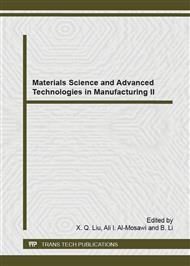p.20
p.25
p.31
p.38
p.43
p.48
p.53
p.58
p.63
Fabrication Microstructure and Microwave Absorption of Fe3O4 Decorated with Hyperbranched Copper Phthalocyanines
Abstract:
In this work, novel Fe3O4–hyperbranched copper phthalocyanines (Fe3O4–CuPc) nanostructures were fabricated via a simple solvent-thermal method, and the electromagnetic absorption property of the composites was investigated. The introduction of CuPc molecules were not only attached to the surface of Fe3O4 in form of beads, but embedded in the interior of Fe3O4. Importantly, the Fe3O4–CuPc composites exhibit excellent microwave absorbability, compared with that of Fe3O4. The composites with a coating layer thickness of 4.0 mm exhibit a maximum absorption of –30.3 dB at 10.2 GHz and the bandwidth below −10.0 dB reaches up to 10.6 GHz (from 7.4 to 18.0 GHz range). The excellent microwave absorption properties are ascribed to the improved impedance matching. The as–prepared novel Fe3O4–CuPc composites are shown to be lightweight, strong absorption, and broad frequency bandwidth microwave absorbers.
Info:
Periodical:
Pages:
43-47
Citation:
Online since:
December 2014
Authors:
Price:
Сopyright:
© 2015 Trans Tech Publications Ltd. All Rights Reserved
Share:
Citation:


